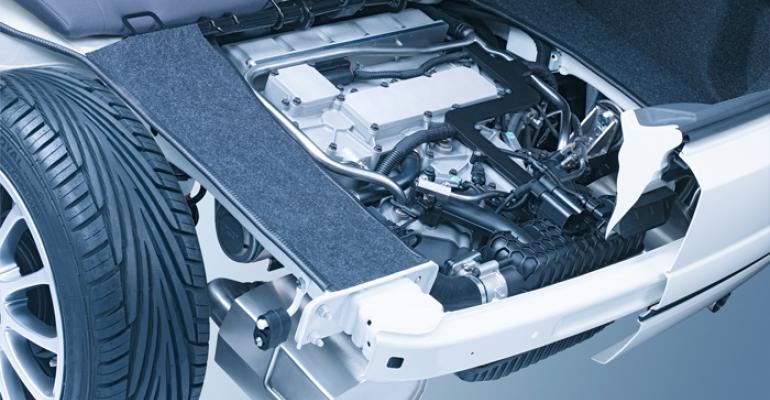DETROIT – General Motors was the first auto maker to introduce a mass-produced extended range electric vehicle, the Chevrolet Volt, in late 2010.
But a German powertrain components supplier is preparing to unveil and potentially market its own solution for the EREV segment, a compact 137-lb. (62-kg) package that includes a 0.8L 2-cyl. gasoline engine, two generators and one electric motor to turn the wheels.
The 30-kW (40-hp) range extender from KSPG Automotive (formerly Kolbenschmidt Pierburg) is intended to fit beneath the cargo floor or under the hood of a subcompact car. KSPG and powertrain engineering firm FEV jointly developed the concept.
At the North American International Auto Show here, a cutaway of the EREV module is displayed in place of the fuel tank in the subcompact Fiat 500. The concept is the centerpiece of KSPG’s first-ever exhibit in a private suite at the Detroit auto show.
Power comes from a 0.8L V-type port-injection 2-cyl. 4-stroke gasoline engine with the pistons horizontally oriented against a vertical crankshaft on a 90-degree angle.
Two permanent-magnet generators, packaged directly next to the V-2 engine, power the battery and feed an electric motor, which drives the front wheels via a differential gear.
The electric motor needs to be packaged near the axle it will drive. KSPG’s system is compatible with all-wheel drive, which requires a second motor positioned near the rear axle.
The 16 kWh lithium-ion battery module and gas tank are positioned under the rear seat in the Fiat 500 concept on display.
Testing is under way, but the system should have an electric-only range of about 50 miles (80 km) and an overall range of about 310 miles (500 km), says KSPG CEO Gerd Kleinert.
With a top speed of 78 mph (125 km/h), Kleinert says the package could handle any highway or surface street around the world, even Germany’s famous autobahn.
Besides having two fewer cylinders in its internal-combustion engine, what sets apart KSPG’s concept from GM’s EREV is its ability to transition between gas and electric propulsion, regardless of the battery’s state of charge.
At low speeds, perhaps below 30 mph (48 km/h), the KSPG engine remains off and the vehicle drives entirely on electric power. Once the vehicle merges onto the highway at higher speeds, the engine kicks on and will stay on until exiting the freeway, even if the battery is fully charged, Kleinert says.
“So you can drive in the city and generate no pollution. You can park your car, and you don’t need to plug it in because you have energy to spare,” he says. “Then when you are home, you plug it in again.”
Another key difference is the drivetrain. The gasoline engine in the Volt will drive the wheels in certain circumstances. Not so with the KSPG concept, which has no connection between the engine and wheels.
Kleinert says the goal is not to compete with or replace the Volt’s technology, which is intended for larger cars. Instead, he says the new system is designed for small cars, especially for families considering an EV as a third vehicle for city driving.
“If you don’t want to buy a third vehicle, this is the one for you,” Kleinert says.
This summer, KSPG hopes to have drivable prototypes so customers can experience the technology.
If a customer wants the system for use in a more spacious vehicle, Kleinert says a larger V-2 range extender could be designed with bigger pistons and cylinders to generate more power.
Among the challenges that remain are quieting some of the noise and vibration on both the intake and exhaust sides of the engine. “That’s the key to guaranteeing the customer, the driver, doesn’t feel it,” he says. “They don’t want to hear it when the combustion engine starts working.”
At least 50% of the content for the concept comes from KSPG, which specializes in pistons, blocks, cylinder heads and other engine components.
Kleinert says it’s too early to build a business case for manufacturing and selling the system.
But he’s convinced a market is emerging for the device, especially as some cities in the world, including London, take steps to ban vehicles with internal-combustion engines.
“A lot of people see this technology as a bridge between today’s internal-combustion engine and future pure electric EVs, if we will ever have them,” Kleinert says. “It all depends on batteries and how good they will be in the future.”
In terms of cost, Kleinert says rough calculations suggest KSPG might be able to deliver the package at a price point acceptable to auto makers.
Also to be decided is whether KSPG would manufacture the units or merely license others to produce them. “Everything is possible,” he says. “But we would be ready to assemble the whole device.”
KSPG also has expanded production with a new plant in Celaya, Mexico, to produce automotive vacuum pumps and electric water pumps. The new building is situated next to a piston manufacturing facility purchased by KSPG in 2006.
“This is one of our most successful plants worldwide right now,” Kleinert says of the Celaya campus.
Half of the new facility already is producing pumps, and the other half will manufacture plain bearings beginning next month. The bearing business was transferred from KSPG’s Pierburg plant in Fountain Inn, SC.
But the South Carolina plant remains busy with additional contracts to assemble throttle bodies, exhaust-gas recirculation valves and exhaust-gas flaps. “The South Carolina plant is now full because of the economy,” he says. “We need to bring additional lines into the plant.”
Fountain Inn is staffed by 110 workers, while the Celaya complex employs 480.
Kleinert says operating costs are 70% lower in Celaya than in Fountain Inn.





